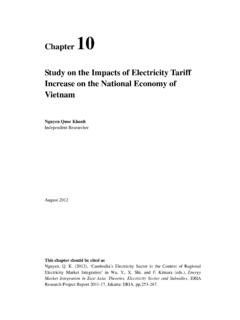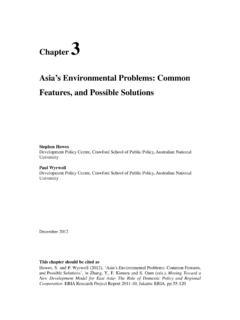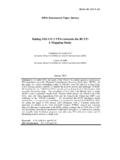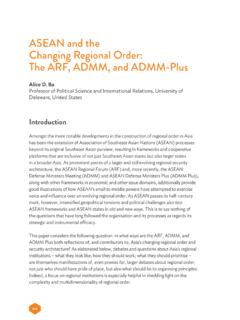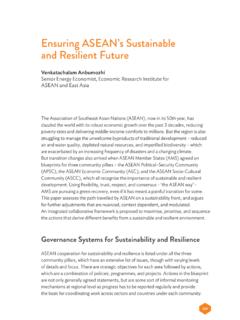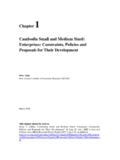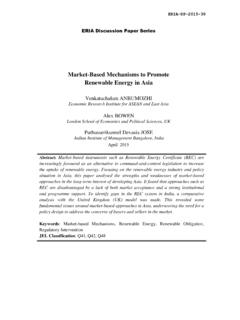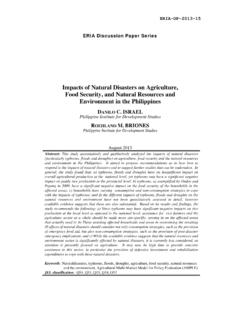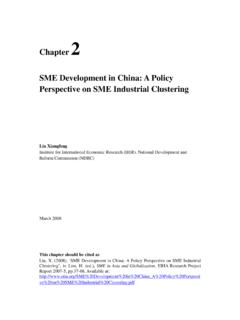Transcription of Domestic Tourism as a Pathway to Revive the Tourism ...
1 ERIA-DP-2021-25 ERIA Discussion Paper Series No. 392 Domestic Tourism as a Pathway to Revive the Tourism Industry and Business Post the COVID-19 Pandemic* Jennifer CHAN Borneo Tourism Research Centre Faculty of Business, Economics and Accountancy, Universiti Malaysia Sabah July 2021 Abstract: This research aims to explore the potential of Domestic Tourism as a means to revitalise the Tourism industry from the perspectives of local residents and Tourism players. A quantitative online survey focused on Domestic travel behaviour, motivation, places of interest, travel preferences, and willingness to travel within Malaysia; it was answered by 219 Malaysians.
2 Interview data were collected using structured, open-ended interview questions through emails to eight respondents from Tourism associations, five from the hotel sector, and two from the travel and tour sector. Data collection was carried out from 10 January to 15 February 2021. The findings reveal that Domestic Tourism has the potential to Revive the Tourism industry. A high percentage of respondents indicated the desire to travel domestically and being motivated by attractive tour packages at discounted prices. COVID-19 has impacted tourist behaviour and attitudes towards travelling, and people prefer to travel domestically rather than overseas.
3 Furthermore, Tourism players acknowledged the potential to Revive the Tourism industry and business via Domestic Tourism . Despite this, declarations of health, safety issues, flight availability, travel restrictions, and quarantine durations are key barriers to stimulating Domestic Tourism and rebuilding the Tourism industry. Keywords: Domestic Tourism ; COVID-19 pandemic; Revitalise Tourism industry JEL Classification: L890 *This research was conducted as a part of the project of Economic Research Institute for ASEAN and East Asia (ERIA) ERIA Research on COVID-19 and Regional Economic Integration.
4 Opinions expressed in this paper are the sole responsibility of the authors and do not reflect the views of ERIA. Corresponding email: 2 1. Introduction The outbreak of the coronavirus disease of 2019 (COVID-19) has had several profound negative impacts on the global economy, society, and the Tourism and hospitality industry since March 2020. Countries and regions have attempted to contain the virus through social distancing, entry and travel bans, quarantines, and movement control orders (BBC News, 2020). Consequently, this has restricted mobility and created feelings of danger, fear of contagion/health issues, and an unwillingness to travel amongst tourists and travellers.
5 Tours and travels have since decreased by 80% 90% in global Tourism cities (UNWTO, 2020a). According to a report from the United Nations World Tourism Organisation (UNWTO, 2020b), between January and March 2020, travel restrictions were imposed for all worldwide destinations. In 2019, Association of Southeast Asian Nations (ASEAN) countries accounted for of all travellers, with East Asia adding another 6% ( Tourism Malaysia, 2019). Asia-Pacific has been one of the hardest-hit areas by COVID-19, and the Tourism economy in the region has come to a complete halt.
6 In 2019, there were over million international tourist arrivals to Asia-Pacific, an increase of from 2018. The Tourism industry employs over million people and accounts for growth in the region. In 2018, Malaysia had the 9th highest international Tourism receipts in Asia-Pacific. Thus, the Tourism industry is the backbone of the economy of many countries in the area. Further, it is of particular importance to the economies in Southeast Asia as it facilitates regional cooperation and promotes cultural and environmental heritage and diversity.
7 However, it is one of the industries most affected by the COVID-19 outbreak. The pandemic has already had and will continue to have an enormously disruptive effect on the global economy in terms of growth and employment. It has created critical scenarios, namely, uncertainties, crises, and resilience; each scenario has had various negative impacts, essential measures, and changes of different magnitudes in the economy and business sectors. Thus, a new business landscape and normality are inevitable. According to the World Travel and Tourism Council (WTTC, 2020), the Tourism industry is likely to recover more slowly than other sectors of the economy, as it took more than 19 months to recover in the case of previous pandemics.
8 3 The Tourism industry is the third-largest contributor to Malaysia s gross Domestic product (GDP) at , amounting to billion (Department of Statistics Malaysia, 2020). Tourist expenditure in 2018 was billion, a increase from 2017, which amounted to of GDP. Employment in the industry also reached million, or of the working population. International visitors accounted for million, and the top 10 sources were all Asian countries Singapore, indonesia , China, Thailand, Brunei Darussalam, the republic of Korea (henceforth, Korea), India, the Philippines, Japan, and Taiwan.
9 Tourism in Sabah provides more than 80,000 jobs, constituting the third-largest economic sector after oil and gas production and agriculture. The top 10 countries in terms of visitation (2013 2020) are China, Korea, indonesia , Brunei, Taiwan, the Philippines, the United Kingdom (UK) and Ireland, Japan, Australia, and Singapore (Sabah Tourism Board, 2020). There was a rapid growth in the arrival of tourists from 2002 to 2019, and Domestic Tourism was greater than international Tourism , as shown in Figure 1. Figure 1. Sabah Tourist Arrivals ( Domestic and International), 2002 2019 Source: Sabah Tourism Board (2020).
10 4 Since 18 March 2020, of all industries, the Tourism industry in Malaysia has been the hardest hit by the measures to contain the spread of COVID-19. The ongoing Visit Malaysia Year 2020 (VMY 2020) campaign target to achieve 30 million arrivals was cancelled (MSN, 2020). The Sabah State Government has implemented an entry ban on foreign travellers since 8 February 2020. As a result of travel restrictions and lockdowns, global Tourism , including to Malaysia, has slowed down significantly. Tourism receipts in Sabah declined by from January to May 2020.
